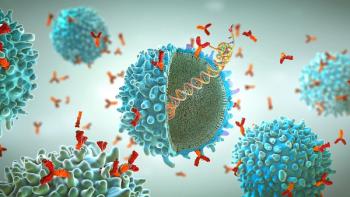
- BioPharm International-06-01-2019
- Volume 43
- Issue 6
Taking Therapeutic Antibodies to the Next Level
This article explores the challenges and potential of next-generation therapeutic antibodies.
Monoclonal antibodies (mAbs) are considered the standard therapy in the biologics industry following decades of research, development, manufacturing optimization, and commercial success. However, they face limitations to their long-term efficacy because they can eventually encounter resistance, such as when a tumor evades immune control (1). Fortunately, advances in protein engineering technology have led to the development of alternative antibody forms, or next-generation antibodies, that may supersede the limitations of mAbs. At the forefront of a new wave of next-gen antibodies are bispecific antibodies, which are capable of targeting multiple antigens as a single agent. Bispecific antibodies can directly target immune cells to a tumor, which suggests that they can significantly reduce drug resistance and severe adverse side effects commonly experienced with other cancer therapies, including mAbs (1).
Road to next-gen antibodies
Over the past 20 years, antibody therapeutics have grown from nothing to a $120-billion market that is the fastest growing sector of therapeutics, says Carl Hansen, PhD, CEO and president of AbCellera, a Canadian biotech company specializing in next-generation therapeutic antibodies, and professor at the University of British Columbia, Vancouver, Canada. The biologics industry has since matured and has grown increasingly more competitive, driving a need for access to new target spaces and for new technologies that provide a competitive advantage, Hansen observes.
“On the one hand, the industry is moving towards target classes that have previously been inaccessible. At the same time, the competition amongst biotechs driving new antibody therapeutics to market has intensified. These market dynamics have placed a premium on high-end discovery technologies capable of finding rare antibodies, as well as access to new sources of antibody diversity that are suited to each specific problem,” says Hansen.
For example, he notes, antibody discovery from camelids provides a means to generate high-affinity single-chain antibodies that can access small epitopes. There is also a trend toward the creation of formats in which a single molecule can engage two (bi-specific) or more (multi-specific) targets. Numerous bispecific formats have been described over the years; however, many of these have encountered challenges in manufacturing. More recently, these manufacturing challenges have been solved using protein engineering methods, and several bispecific molecules have advanced into the clinic, including immunoglobulin G (IgG)-like formats and nanobody molecules, which are truncated single-chain antibodies. The latter can be linked together to create constructs that are both simple to manufacture and that are capable of targeting more than one epitope or drug target at once, Hansen explains.
“Alternative scaffolds are a novel class of biologic molecules that have been specifically developed to address identified shortcomings of mAbs,” adds Dr. Fredrik Frejd, chief scientific officer of Affibody, a Swedish biotech company specializing in next-generation biopharmaceuticals. “Alternative scaffolds are the focus of companies such as Affibody, Molecular Partners, and Pieris, and they feature on par molecular diversity and ability to bind with high affinity in a structure that is often better and very different from mAbs.”
Alternative (aka, protein) scaffolds, which are derived from non-immunoglobulin proteins endowed with novel binding sites (2), are used to generate novel binding proteins via combinatorial engineering. They have recently emerged as a compelling alternative to natural or recombinant antibodies. The concept of this scaffold requires an “extraordinarystable protein architecture tolerating multiple substitutions or insertions at the primary structural level” (3).
Affibody has developed alternative-scaffold molecules, called Affibody molecules, that have shown substantial clinical usefulness in oncology and inflammation indications. The company currently has ongoing clinical trials with three different Affibody molecules in Phase II/Phase III for breast cancer imaging, Phase II for psoriasis, and Phase I for autoimmune diseases, respectively.
Therapeutic potential
Emerging antibody formats provide a variety of advantages, Hansen comments. Bispecific antibodies, for example, provide the ability to modulate multiple targets in a single molecule, to direct cell-cell interactions (T cell engagers), to increase target engagement on multiple epitopes, and to increase therapeutic windows by selectively targeting tissues or cell types.
Researchers have been able to take the modular architecture of antibodies and create more than 60 different bispecific antibody formats that vary in molecular weight, number of antigen-binding sites, spatial relationship between different binding sites, valency for each antigen, ability to support secondary immune functions, and pharmacokinetic half-life, according to a study by C. Spiess et al.(4). Having these diverse formats allows for tailoring the design of bispecifics to match a proposed mechanism of action and toserve an intended clinical application.
The Affibody molecules, meanwhile, offer therapeutic potential via their high molecular diversity and high stability as well as by demonstrating high affinity-down to femtomolar affinity-when binding to targets. “Higher subcutaneous doses due to smaller molecular size translate to greater clinical efficacy than antibodies, and the smaller size results in better tissue penetration and access to the disease target,” says Frejd.
Alternative scaffolds offer improved manufacturability and can facilitate new functional combinations, which is likely to enable unique therapeutic modes of action that can yield promising therapeutics, such as biobetters (2). Affibody molecules, specifically, can be manufactured with predictable processes at low cost and offer engineering options not accessible for antibodies, according to Frejd.
Challenges to development
Next-gen therapeutic antibodies face many challenges, and bispecific antibody challenges in particular include the engineering, development, and manufacture of the molecules, says Hansen. “Much of the work on bispecifics has focused on solving the manufacturing problem of producing complex molecules with a single cell line with good purity and yield,” he comments.
“AbCellera’s platform is displacing discovery using traditional hybridoma or display approaches, two technologies that have changed little over the past two decades. Our microfluidic platform allows the direct assessment of antibodies produced by a single cell in hours and can be applied on a massively parallel scale to screen more than a million single cells per day. As compared to hybridoma methods, our process completely bypasses the need for a fusion step where the large majority of antibody leads are lost, thereby allowing an ultradeep search of natural immune systems. By unlocking the full diversity of natural immune responses, we can produce large panels of naturally derived antibodies, which generally have superior potency, specificity, and developability as compared to those obtained from synthetic display libraries,” Hansen adds.
In comparison, Affibody molecules offer biparatopic and multispecific constructs that can be generated at a fraction of the size and cost of an antibody, which allows for a switch from intravenous-infusion dosing regimes conducted in the clinic to a more convenient subcutaneous self-administration at home. “Typically, the production is scalable and predictable, and as the building blocks in the bi/multi specific constructs are synthetic, there are fewer surprises in the generation of the molecular formats. While two binding domains remain a limit for many antibody formats, tri- and multispecific constructs are routine with Affibody molecules,” Frejd states.
References
1. A. Thakur et al.,
2. M. Gebauer and A. Skerra, “
3. P.A. Nygren and A. Skerra, J Immunol Methods. 290 (1–2) 3–28 (2004).
4. C. Spiess et al.,
Article Details
BioPharm International
Volume 32, No. 6
June 2019
Pages: 14–16
Citation
When referring to this article, please cite it as F. Mirasol, "Taking Therapeutic Antibodies to the Next Level," BioPharm International 32 (6) 2019.
Articles in this issue
over 6 years ago
FDA Advances New Approach to Drug Quality Assessmentover 6 years ago
Bio/Pharma Facilities Still Have a Lot to Learnover 6 years ago
Moving PAT from Concept to Realityover 6 years ago
Streamlining Upstream Processing: A Good Place to Startover 6 years ago
On the Right Trackover 6 years ago
Quality Agreements and Out-of-Specification Investigationsover 6 years ago
Addressing the Complex Nature of Downstream Processing with QbDover 6 years ago
BioPharm International, June 2019 Issue (PDF)Newsletter
Stay at the forefront of biopharmaceutical innovation—subscribe to BioPharm International for expert insights on drug development, manufacturing, compliance, and more.




